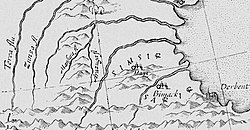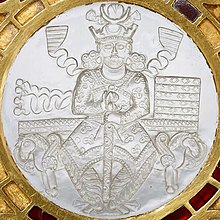
Derbent, formerly romanized as Derbend, is a city in Dagestan, Russia, located on the Caspian Sea. It is the southernmost city in Russia, and it is the second-most important city of Dagestan. Derbent occupies the narrow gateway between the Caspian Sea and the Caucasus Mountains connecting the Eurasian Steppe to the north and the Iranian Plateau to the south; covering an area of 69.63 square kilometres (26.88 sq mi), with a population of roughly 120,000 residents.
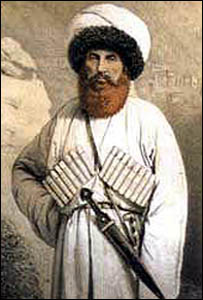
The Avars, also known as Maharuls, are a Northeast Caucasian ethnic group. The Avars are the largest of several ethnic groups living in the Russian republic of Dagestan. The Avars reside in the North Caucasus between the Black Sea and the Caspian Sea. Alongside other ethnic groups in the North Caucasus region, the Avars live in ancient villages located approximately 2,000 meters above sea level. The Avar language spoken by the Caucasian Avars belongs to the family of Northeast Caucasian languages. Sunni Islam has been the prevailing religion of the Avars since the 14th century

Dagestan, officially the Republic of Dagestan, is a republic of Russia situated in the North Caucasus of Eastern Europe, along the Caspian Sea. It is located north of the Greater Caucasus, and is a part of the North Caucasian Federal District. The republic is the southernmost tip of Russia, sharing land borders with the countries of Azerbaijan and Georgia to the south and southwest, the Russian republics of Chechnya and Kalmykia to the west and north, and with Stavropol Krai to the northwest. Makhachkala is the republic's capital and largest city; other major cities are Derbent, Kizlyar, Izberbash, Kaspiysk, and Buynaksk.

The peoples of the Caucasus, or Caucasians, are a diverse group comprising more than 50 ethnic groups throughout the Caucasus.

Juansher was the Mihranid prince of Caucasian Albania, ruling the principality from 637 to 669. He was the son and successor of Varaz Grigor.

The Avar Khanate, the Avar Nutsaldom, also known as Khundzia or Avaria, was a long-lived Avar state, which controlled mountainous parts of Dagestan from the early 13th century to the 19th century.
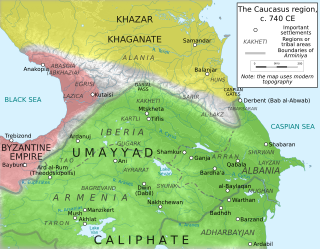
The Arab–Khazar wars were a series of conflicts fought between the Khazar Khaganate and successive Arab caliphates in the Caucasus region from c. 642 to 799 CE. Smaller native principalities were also involved in the conflict as vassals of the two empires. Historians usually distinguish two major periods of conflict, the First Arab–Khazar War and Second Arab–Khazar War ; the wars also involved sporadic raids and isolated clashes from the mid-seventh century to the end of the eighth century.
Alania was a medieval kingdom of the Iranian Alans (Proto-Ossetians) that flourished between the 9th–13th centuries in the Northern Caucasus, roughly in the location of latter-day Circassia, Chechnya, Ingushetia, and modern North Ossetia–Alania. With its capital at Maghas, the location of which is still disputed, it became independent from the Khazars in the late 9th century. It was Christianized by a Byzantine missionary soon after, in the early 10th century.
The Church of Albania or the Albanian Apostolic Church was an ancient, briefly autocephalous church established in the 5th century. In 705, It fell under the religious jurisdiction of the Armenian Apostolic Church as the Catholicosate of Aghvank centered in Caucasian Albania, a region spanning present-day northern Azerbaijan and southern Dagestan.
Lakia is an ancient ethnic region within the state of Dagestan. Its historical capital is Kumukh, one of the ancient cultural and religious centres of Lakia. The people of Lakia are self-designated as Laks and their native language is Lak.

"Gazikumukh Shamkhalate" is a term introduced in Russian-Dagestan historiography starting from the 1950s–60s to denote the Kumyk state that existed on the territory of present-day Dagestan in the period of the 8th to 17th centuries with the capital in Gazi-Kumukh, and allegedly disintegrated in 1642. However, In the 16th century's Russian archival sources Tarki is stated to be the "capital of Shamkhalate" and "the city of Shamkhal", while "Kazi-Kumuk" is mentioned as a residence. These facts contradict "1642 disintegration" date. Moreover, there is absolutely no source before the 1950s containing the term "Gazikumukh Shamkhalate" or a statement that Gazi-Kumukh had ever been the capital of Shamkhalate. Historically, Shamkhalate is widely described as Tarki Shamkhalate or just Shamkhalate.
Gazikumukh Khanate was a Lak state that was established in present-day Dagestan after the disintegration of Gazikumukh Shamkhalate in 1642. Its peoples included various Lezgin tribes and Avars.
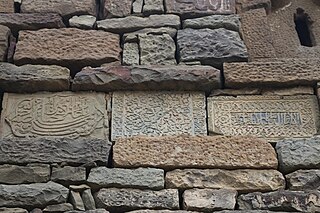
Historically, Dagestan consisted of a federation of mountainous principalities in the eastern part of the North Caucasus. Located at the crossroads of world civilizations of north and south, Dagestan was the scene of clashes of interests of many states and until the early 19th century, most notably between Iran and the Russian Empire.
Ahmad of Shirvan was the eighth Shah of Shirvan.

The Maskut were a group of Massagetaen-Sarmato-Alanian tribes located in the eastern part of the Caucasus, along the western coast of the Caspian Sea. They lived between Derbent and Shaporan, which corresponds to present-day northeast Azerbaijan and southeast Dagestan (Russia). The name "Maskut" is also sometimes used to refer to a geographic area, rather than an ethnic group. The first wave of these tribes arrived in the 3rd-century from the Volga–Don Canal and the northern coast of the Caspian Sea. The modern Russian-Dagestani historian Murtazali Gadjiev suggests that these tribes had immigrated as a result of not only climate changes and longing to explore new regions, but as well as due to concurrent conflicts.
In the history of Azerbaijan, the Early Middle Ages lasted from the 3rd to the 11th century. This period in the territories of today's Azerbaijan Republic began with the incorporation of these territories into the Sasanian Persian Empire in the 3rd century AD. Feudalism took shape in Azerbaijan in the Early Middle Ages. The territories of Caucasian Albania became an arena of wars between the Byzantine Empire and the Sassanid Empire. After the Sassanid Empire was felled by the Arab Caliphate, Albania also weakened and was overthrown in 705 AD by the Abbasid Caliphate under the name of Arran. As the control of the Arab Caliphate over the Caucasus region weakened, independent states began to emerge in the territory of Azerbaijan.
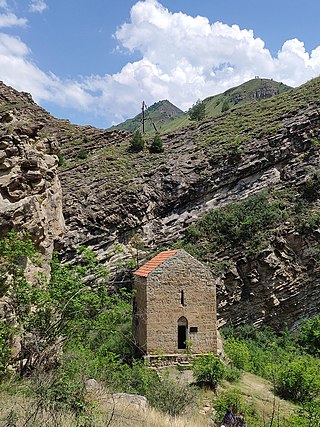
Datuna Church is the only medieval church that survives in modern Dagestan. It is situated in the Shamilsky District, about 4 km south of the village of Datuna.
Saratan I or Sirtan (11th-century) was a nutsal (ruler) of the state formation Avar Nutsaldom.
Surakat I or Suraka was an Avar nutsal (ruler), who ruled in the 11th–13th and the son of previous ruler Saratan.

Muhammad-nutsal IV the Brave also known as Nursal-bey or Mersel-khan was an Avar nutsal (ruler), who ruled from 1735 to 1774.
